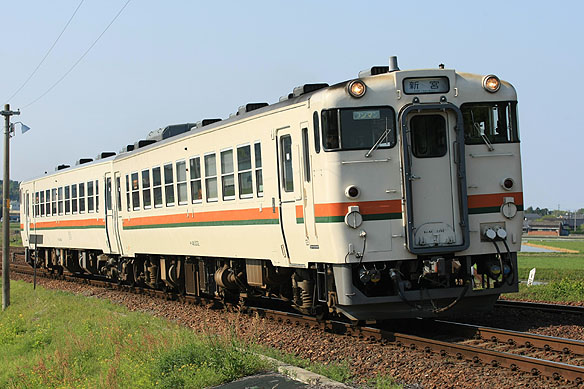Background and overview
Japanese National Railways (JNR) had delivered class kiha48-500/-1500 single-cab diesel multiple unit (DMU) trains for unelectrified lines in cold district from 1979. However, JNR developed class kiha48-0/-1000 single-cab diesel multiple unit (DMU) trains for Mino, Gifu pref. and Reinan, Fukui pref. affected by snow lighter than other cold region for cost reduction in 1981. At the splitting of JNR into the privatized JR companies, JR Central received 5 vehicles of class kiha48-0/-1000 and JR West 5 in 1987.
Car body
Bodies constructed by weatherproof high-tension steel have 20806mm long
and 2930mm wide body having 1.6mm thick skin and 1.2mm thick roof. Their
gangwayed cab ends are constructed with 4.5mm thick plat and employed raised
driver's cab e for the protection against obstacles at the level crossing.
Expansible sealing rubber is applied for a gangway door to prevent cold
air from entering through the gap between a gangway door and door frame.
A destination rollsign is fitted with above the gangway and two headlights
employing the sealed beam light bulb are fitted with each side of the front
rollsign. They are equipped with two 1,000mm wide stepped single leaf semi-automatic
sliding doors employing the door operating equipment, TK105, fitted with
above the door header of the door and double-hung unit assembled windows,
the upper sash of which moves down and the lower moves up, between the
doors. Forced draught ventilators and two FRP water tanks fitted with inside
the steel cover are fitted with on the roof. They are also equipped with
two heat exchangers rated at 15,000kcal/h under their floor to supply heated
air to passenger room by electric fan. Their bodies are painted in vermilion.
Bogies
They are equipped with a powered bogie, DT22D, and a trailer bogie, TR51C, featuring pedestal guide type journal supporting system, coil springs secondary suspension, and 1-axle drive. Brake rigging is the single tread brake powered by the body mounted brake cylinder.
Traction unit and ancillary equipments
Class kiha48-500/1500 vehicles are powered by a diesel prime mover, DMF15HSA, with a power output of 220PS, employing the individual cylinder head and the supercharger, TB15, to achieve higher power output. Their hydraulic transmission gear is DW10, which is made several improvements on DW9 employed for kiha66 series DMU, incorporating oil filling and draining type three-member single-stage torque converter and multi-plate wet clutch. They are equipped with an air compressor, CW750D, powered by a prime mover. Their brake system is the automatic electromagnetic (CLE) air brake.
Accommodation
Seating is arranged as mixture of longitudinal bench seating and 4-seat transverse seating bays with 1470mm seating pitch. Electric fans are fitted with under the ceiling. They are vestibuled. Class kiha48-500 vehicles are equipped with a Japanese style toilet at the end of the vehicles.
Modification
JR Central
Class kiha48-5000
JR Central fitted 3 kiha48-0 vehicles with a self-powered air conditioner,
C-AU27, over the period from 1989 until 1990. Then JR Central replaced
a prime mover and a hydraulic transmission with C-DMF14HZB with a power
output of 350PS and C-DW14A and classified into -5000 subclass over the
period from 1995 until 1999.
Class kiha48-5300
JR Central equipped 2 kiha48-5000vehicles with the ticket machines to issue the ticket indicating the boarding station at the doorways, the fare box near the driver's seat, the fare display behind driver's cab, and buttons to open/close doors manually for the conductor-less operation and classified them into -5300 subclass in 2000 and 2003.
Class kiha48-6000
JR Central fitted 2 kiha48-1000 vehicles with a self-powered air conditioner, C-AU28, in 1990. Then JR Central replaced a prime mover and a hydraulic transmission with C-DMF14HZB with a power output of 350PS and C-DW14A and classified into -6000 subclass in1996 and 1997.
Class kiha48-6300
JR Central equipped kiha48 6002 with the ticket machines to issue the ticket indicating the boarding station at the doorways, the fare box near the driver's seat, the fare display behind driver's cab, and buttons to open/close doors manually for the conductor-less operation and classified them into -6300 subclass in 2000.
JR West
JR West began to equip all of kiha48-0 vehicles and kiha48-1000 vehicles
with a self-powered air conditioner, AU34, rated at 26,000kcal/h in 1992
and 1993. Likewise, JR West replaced a prime mover and a hydraulic transmission
with SA6D125H-1A of Komatsu Ltd. and KTF3335A-1A of Komatsu Ltd in order
to reduce maintenance cost and improve running performance. Moreover, the
refurbishment programme was also commenced in having body repairment, replacement
with flush surfaced window frame made of aluminum, decorative panel replacement,
and buttons to open/close doors manually, and an air conditioner replacement
with a prime mover driven air conditioner, WAU201, rated at 27,000kcal/h
for life-extension.
Operations
Class kiha48-0/-1000 had been used on rural services on unelectrified lines in Mino and Reinan regions. Vehicles used in Reinan region were relocated to Yamaguchi region. Then they were relocated to Okayama and Toyama. However, vehicles allocated at Okayama were scrapped. On the other hand, vehicles used in Mino region were relocated to be used on rural services of Kisei line. However, they had completely been withdrawn by replacement with class kiha25 in 2016. |
|

